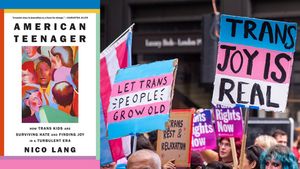
CONTACTStaffCAREER OPPORTUNITIESADVERTISE WITH USPRIVACY POLICYPRIVACY PREFERENCESTERMS OF USELEGAL NOTICE
© 2024 Pride Publishing Inc.
All Rights reserved
All Rights reserved
By continuing to use our site, you agree to our Private Policy and Terms of Use.
Everyone knows that insecurities and peer pressure make teenagers susceptible to tobacco use, but in the case of LGBT youths, it has long been suspected that the unique challenges associated with having a minority sexual orientation and/or gender identity heighten their smoking risk. For the first time, a new survey explores the links between the stress of antigay discrimination and teenage tobacco use and suggests improved prevention strategies.
The report, "Coming Out About Smoking: Tobacco Use in the LGBTQ Young Adult Community" was released Tuesday by the National Youth Advocacy Coalition (NYAC), a Washington, D.C.-based organization that works to empower LGBT youths. Like many projects in LGBT health, it began as way to fill significant gaps in knowledge, where little has been studied about the reasons why LGBT youths smoke.
"You'll find that there is information out there about LGBT people and smoking, but it's never really whittled down to youth, which is the problem with lots of our health issue these days," said Jb Beeson, the deputy executive director of NYAC. "Youth aren't studied as part of the priority observation."
Reaching young people is critical in the case of smoking, where most smokers start by the age of 18. Using Facebook to promote their effort, NYAC generated almost 1,000 replies to an online survey over the past year, followed by work with five diverse focus groups at community-based organizations in New York, Florida, Illinois, Oregon, and Utah. Participants were asked a range of questions, including how they felt about tobacco, the tobacco industry, their smoking habits, and social factors in their lives like stress.
The data showed that specific challenges related to sexual orientation and gender identity prompted LGBT youths to smoke, often as a way to find acceptance. Among the circumstances faced by this group are higher rates of family rejection, homelessness and suicide.
"Young adults are feeling stressed out and they're feeling stressed from discrimination and they're families and from school," said Beeson. "They're looking for an outlet from that stress, but they also looking to build community. When those two things collide, it makes an easy, social way for them to get through stress."
While the connection may seem obvious, establishing the links between LGBT youths and smoking through a formal survey can provide a boost to organizations, which now have statistics to use when applying for grants and designing programs. The survey also provides insight into prevention strategies, for example, by revealing that LGBT youths tend not to smoke heavily and in many cases want to quit. This suggests a need for programs designed by youth and tailored to their uniquely stressful lives, with an emphasis on early outreach and explicit education about the serious dangers of smoking.
"As a queer community, we know these things and we want to do something about it, but without statistics and facts and putting it out there in a comprehensive way, there is little we can do about it," said Beeson. "What we're really asking for is that more research needs to be done."
Read the full report here.
From our Sponsors
Most Popular
31 Period Films of Lesbians and Bi Women in Love That Will Take You Back
December 09 2024 1:00 PM
18 of the most batsh*t things N.C. Republican governor candidate Mark Robinson has said
October 30 2024 11:06 AM
True
After 20 years, and after tonight, Obama will no longer be the Democrats' top star
August 20 2024 12:28 PM
Trump ally Laura Loomer goes after Lindsey Graham: ‘We all know you’re gay’
September 13 2024 2:28 PM
Melania Trump cashed six-figure check to speak to gay Republicans at Mar-a-Lago
August 16 2024 5:57 PM
Latest Stories
Donald Trump promises transphobic policies that will target youth and service members on 'day one'
December 23 2024 12:28 PM
Matt Gaetz allegedly paid tens of thousands of dollars for sex and drugs: House Ethics report
December 23 2024 10:41 AM
Freemasons, gay men, and corrupt elites in Cameroon — inside a conspiracy theory
December 21 2024 12:51 PM
Kathy Hochul vetos financial protection bill introduced after murders of gay men
December 21 2024 12:29 PM
35 pics of celebs uniting at David Barton & Susanne Bartsch Toy Drive 2024
December 20 2024 5:01 PM
From Saturnalia to Santa, is Christmas just drag in disguise?
December 20 2024 4:44 PM
Out and About with Billy Eichner
December 20 2024 3:25 PM
Tennessee pizzeria refuses to cater same-sex weddings
December 20 2024 1:43 PM
Meet Bobbie Simpson: California’s first out trans school board member
December 20 2024 12:05 PM
Here are the 30 transgender Americans lost to violence so far this year
December 20 2024 11:12 AM
















































































Viral post saying Republicans 'have two daddies now' has MAGA hot and bothered